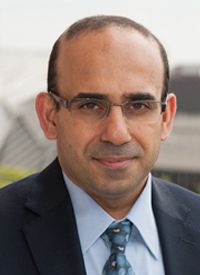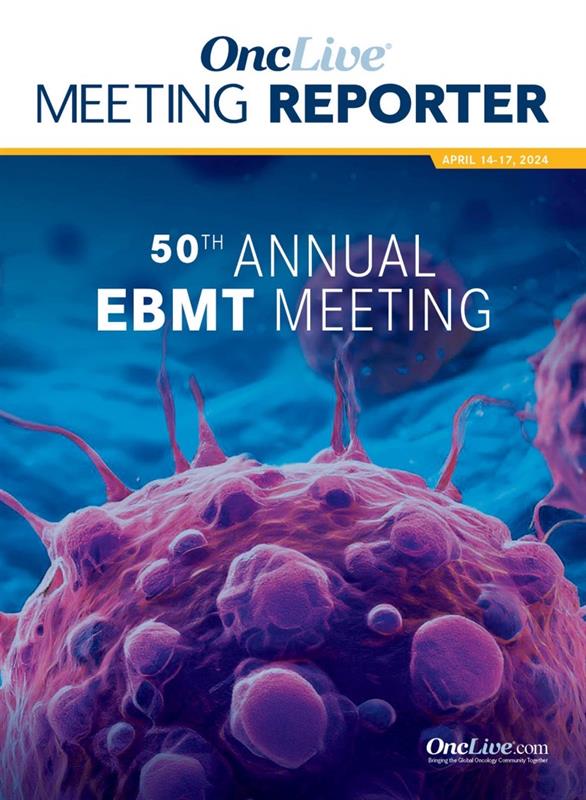Mohty Shares Key Takeaways From the 50th Annual EBMT Meeting, Highlighting Advances in GVHD
Mohamad Mohty, MD, PhD, highlights key takeaways from the 50th Annual EBMT Meeting, focusing on ongoing efforts within the GVHD treatment arena.
Mohamad Mohty, MD, PhD

At the 50th Annual EBMT Meeting, clinicians and researchers highlighted advancements in the blood and bone marrow transplant field, including significant advances centering on criteria for donor selection in allogeneic stem cell transplantation (ASCT) and ongoing efforts to refine outcomes and reduce complications in patients with graft-versus-host disease (GVHD), according to Mohamad Mohty, MD, PhD.
In an interview with OncLive®, Mohty highlighted key takeaways from the meeting, emphasizing the discussions that revolved around donor selection criteria, as well as the impact that haploidentical donors and other donor sources may have on patients' needs.
“The 2024 EBMT Meeting was a very exciting meeting; we celebrated the 50th anniversary of the European Society for Blood and Marrow Transplantation [EBMT], which was originally founded in 1974,” Mohty said. “This EBMT Annual Meeting proved to be very successful, and we [saw] the greatest advances in this field.”
In the interview, Mohty discussed the implementation of post-transplant cyclophosphamide for GVHD prophylaxis, highlighted efforts to optimize cyclophosphamide dosing to minimize complications when treating this disease, and noted future directions for this research.
Mohty is a professor of hematology, as well as the head of the Hematology and Cellular Therapy Department at the Saint-Antoine Hospital and Sorbonne University in Paris, France. He is also a member and lead of the translational research team at the Saint-Antoine Research Center and is the chairman of the Acute Leukemia Working Party for the EBMT.
OncLive: What were the main themes of the recent EBMT meeting?
Mohty: What was striking for me were the criteria for choosing donors [and] the implementation and [expansion] of the use of posttransplant cyclophosphamide [PTCy] for GVHD prophylaxis. There are also novelties in the management of acute, especially steroid-refractory, but also ruxolitinib-refractory, GVHD. We’ve seen some great advances when it comes to cGVHD, and overall, this was a memorable EBMT meeting where milestone data were presented.
What data were presented on the criteria for choosing donors, and how have they helped further inform practice?
When it comes to choosing a suitable stem cell donor [for] ASCT, there is a lot of excitement about the use of haploidentical donors. When combining matched sibling donors, fully matched unrelated donors, mismatched unrelated donors, and now haploidentical donors, you’re able to find a suitable donor for approximately 95% of patients who need an ASCT. Although the use of cord blood cells has decreased over the past few years in the adult population, if you use cord blood cells [with] the new technologies and platforms for cord blood expansion, you would be able to cover approximately 100% of [patient] needs.
Interestingly, when it comes to living donors, the age of the donor remains an important parameter. Favoring a young donor, whether in the setting of haploidentical or unrelated donors, is likely to be an important parameter. Also, having a female donor to a male recipient remains an important risk factor for alloreactivity, especially in cGVHD. What remains controversial is how to choose between a young haploidentical donor, if available, and a young, fully matched, unrelated donor. Here we don’t have a final response to this question.
There are teams who now rely almost exclusively on family donors, and this would include matched sibling donors and haploidentical donors. There are still teams who prefer to have fully matched 10 out of 10 unrelated donors. This is proving to be very exciting, and despite the debates, the good news is [there is a possibility of] finding a donor for almost everybody who needs an ASCT.
When you say that younger patients are favorable donors, does this refer to chronological age or biological age?
Age of the donor is important when selecting a given donor—on the other hand, you must take into account the age of the recipient [too]. When it comes to the recipient’s age, it is very important to consider the comorbidities, which will play an important role in the final outcome. We know from daily clinical experience that a patient who is 60 years old—but has comorbidities such as hypertension, diabetes, a heavy smoking history, and cardiovascular complications—[will be affected by] these comorbidities. [They will] negatively impact the incidence of nonrelapse mortality.
However, a patient who’s 70 years old but also fit and without any comorbidities [will] have a lower likelihood of developing toxicities. We can see an important separation between biological age vs physiological age, which is correlated with comorbidities. The development of comorbidity indexes and trying to use new electronic artificial intelligence tools to try to predict outcomes are going to be major [focuses] of future research.
What data supported the entrance and now increased use of PTCy over more historical paradigms?
The use of posttransplant high-dose cyclophosphamide has, in the past 15 years, proved to be a major breakthrough in ASCT because it has allowed safe haploidentical stem cell transplantation [to be performed for the first time, thus] allowing for engraftment while reducing the risk of severe aGVHD and cGVHD.
The use of PTCy has rapidly spread because it is a relatively cheap drug and physicians are quite familiar with the use of cyclophosphamide, as it is a very common drug in hematology and oncology. It has great efficacy in depleting the alloreactive T cells. Now there is an accumulating body of evidence explaining the mechanism of action that allows PTCy to effectively prevent GVHD.
[Although] the initial experience started in the haploidentical setting, use of PTCy is spreading beyond haploidentical transplant and is being used increasingly in the mismatched unrelated setting. Some teams are also using it in the unrelated matched sibling setting. These are the positives with use. We also know with some long-term follow-up and greater experience that high-dose PTCymay not be suitable or safe for everybody because there is a risk of cardiac complications, which were described especially in patients with cardiovascular risk factors. We also know [there is] the high risk of hemorrhagic cystitis related to the BK virus.
At the EBMT meeting, we saw very nice translational work showing that PTCy can impact the immune repertoire and immune anti-infectious control—that can explain the higher incidence of infectious and opportunistic infections after PTCy. With this background, efforts are aiming to test lower doses of PTCy, and our team presented data on reducing the dose by 20% or even 30%.
For instance, [we used] 35 mg/kg per day for 2 days on day 3 and day 4 or day 3 and day 5. You can achieve similar GVHD prevention while reducing the risk of complications, especially cardiac [and] infectious complications, but also shortening the duration of neutropenia and thrombocytopenia. This needs to be validated in prospective future randomized trials, but the use of PTCywill continue to grow. This is something that will make the ASCT procedure safer and more feasible, especially in older and frail patients.

Latest Conference Coverage
2 Commerce Drive
Cranbury, NJ 08512



